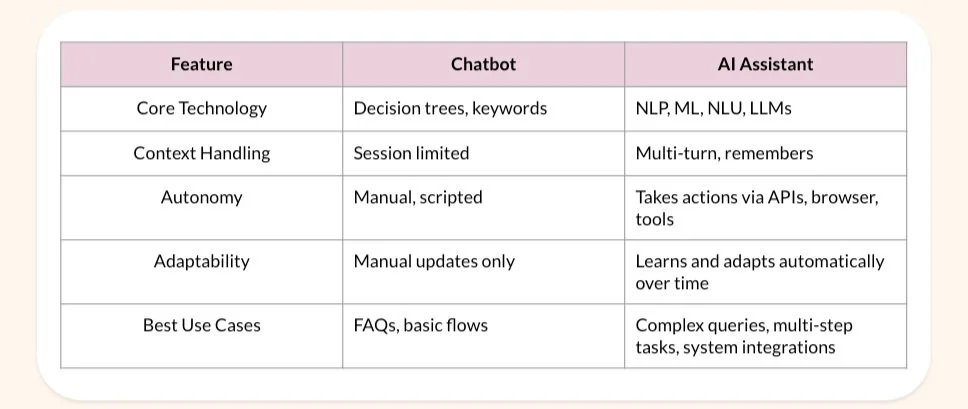AI Assistant vs Chatbot: A Tell-All
If you’ve ever shouted “representative!” at a blinking chat window or had a bot respond to a yes-or-no question with a five-paragraph reply, you know the pain. A lot of what gets called AI today is just a decision tree wearing a hoodie and hoping you won’t notice.
So what is a Chatbot, really?
At its core, a chatbot is rule-based software. It follows decision trees or keyword-matching scripts that someone pre-wrote in advance. The system relies on structured logic, not real comprehension. That can be useful when questions are simple, repetitive, and phrased precisely.
Under the hood, most chatbots use pattern recognition or flow-based architecture. They map user inputs to fixed outputs without actually interpreting meaning. If you ask a question outside that narrow range, they either guess or break.
Chatbots are:
Good at menu navigation ("Press 1 for this, 2 for that")
Decent for basic tasks like routing or answering FAQs
Unable to process intent or context the way AI does
They can be helpful when tightly scoped, but they don’t understand what you’re asking. They just match it to the closest script and hope for the best.
What Makes AI Different?
AI assistants work differently. They use natural language processing (NLP), natural language understanding (NLU), and large language models (LLMs) to make sense of what someone is asking, even if it’s phrased in a way they haven’t seen before.
Instead of following a script, they search your documents in real time and respond with answers that are specific, relevant, and sound like something your team would actually say.
AI assistants can:
Understand open-ended questions.
Pull answers from your own policies and materials.
Handle context across multiple back-and-forth exchanges.Improve over time through usage and feedback.
This is where the real difference shows up. Chatbots rely on keywords and rigid flows. They’re fine for FAQs but fall apart when someone asks something slightly different or combines two topics in one question.
AI assistants are designed to interpret. They keep up when the conversation shifts or gets more specific. If someone asks, “Can I advertise a coming soon listing on Facebook?” and follows up with “What if I’m a secondary member?” the assistant stays with them.
Learning vs. Lockstep
Chatbots are static.
Chatbots only improves if and when someone manually rewrites the script.
AI assistants learn as they go. They use feedback loops and retraining to get smarter. They recognize patterns, improve responses, and evolve as your business grows.
Beyond Q&A
Most chatbots stop at answering questions.
AI assistants can go further. Some can pull data from connected systems, route tasks, or trigger workflows. They don’t just respond. They actually help get things done.
Where Chatbots Fall Short (and Burn Trust)
They can’t handle nuance.
Anything outside the script can lead to errors, confusion, or dead ends.They feel robotic.
Responses are often stiff, repetitive, or totally off.They don’t learn.
No improvement happens unless someone updates the script.They lose credibility.
One bad experience and users stop trusting anything that looks like a bot.
Let’s say your agent asks, “Can I run Facebook ads on a coming soon listing?” A chatbot might not even recognize the question unless it’s typed exactly how it was programmed. An AI assistant trained on your brokerage or MLS policies will understand what’s being asked, search your documentation, and respond with the right policy in seconds.
So... Which One Do You Need?
Ask yourself:
Are your users asking simple questions over and over?
Or are they asking complex questions with lots of variations?
Are you trying to redirect support volume, or actually reduce it?
If you want something that sounds like your staff and solves real problems, you need an AI assistant.
Final Thought
This isn’t just a language mix-up. It’s a functionality gap. A chatbot gives you shortcuts. An AI assistant gives you smart, scalable support that keeps getting better. If you’re investing in automation, choose a tool that actually understands your business and helps your people do their jobs more easily.
Up Next: How to Launch Without Losing Your Mind
A stress-free AI rollout guide, without the jargon, panic, or 93-slide deck.

